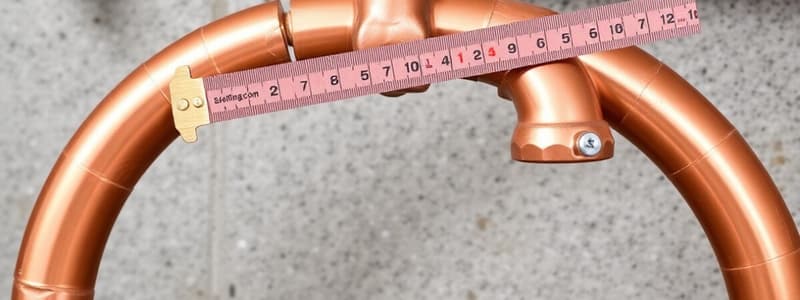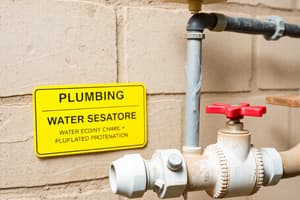Podcast
Questions and Answers
What is the correct conversion of 1000 millimetres to metres?
What is the correct conversion of 1000 millimetres to metres?
Which of the following tools is specifically used for bending pipework?
Which of the following tools is specifically used for bending pipework?
Which of the following grades of copper is classified as 'soft'?
Which of the following grades of copper is classified as 'soft'?
What is a common length for purchasing R250 half hard copper?
What is a common length for purchasing R250 half hard copper?
Signup and view all the answers
For which purpose is the laser distance metre primarily used?
For which purpose is the laser distance metre primarily used?
Signup and view all the answers
Which method requires training before use when threading LCS?
Which method requires training before use when threading LCS?
Signup and view all the answers
What is the main purpose of coating copper pipes?
What is the main purpose of coating copper pipes?
Signup and view all the answers
What is a significant advantage of bending copper pipe instead of using fittings?
What is a significant advantage of bending copper pipe instead of using fittings?
Signup and view all the answers
What is the nominal bore size referred to if it is a ¾ inch LCS?
What is the nominal bore size referred to if it is a ¾ inch LCS?
Signup and view all the answers
Which of the following is NOT a common bending type mentioned?
Which of the following is NOT a common bending type mentioned?
Signup and view all the answers
What occurs to the material on a pipe during bending?
What occurs to the material on a pipe during bending?
Signup and view all the answers
What is the common method to determine the radius center line of a bend in relation to the pipe's diameter?
What is the common method to determine the radius center line of a bend in relation to the pipe's diameter?
Signup and view all the answers
What is the first action that should be taken after cutting LCS tube to ensure safety?
What is the first action that should be taken after cutting LCS tube to ensure safety?
Signup and view all the answers
Which of the following tools is commonly used for bending small bore copper tubes?
Which of the following tools is commonly used for bending small bore copper tubes?
Signup and view all the answers
What type of dies are used for threading LCS?
What type of dies are used for threading LCS?
Signup and view all the answers
What is the correct method for calculating the total length of a pipe when given a radius of 60mm and two additional lengths of 300mm and 150mm?
What is the correct method for calculating the total length of a pipe when given a radius of 60mm and two additional lengths of 300mm and 150mm?
Signup and view all the answers
Which bending method generally ensures accuracy when multiple bends are required?
Which bending method generally ensures accuracy when multiple bends are required?
Signup and view all the answers
What does the X dimension represent in the context of measuring pipe lengths?
What does the X dimension represent in the context of measuring pipe lengths?
Signup and view all the answers
Which grade of low carbon steel is identified by a red color and is typically used for steam and fire systems?
Which grade of low carbon steel is identified by a red color and is typically used for steam and fire systems?
Signup and view all the answers
What material composition is low carbon steel made from?
What material composition is low carbon steel made from?
Signup and view all the answers
Study Notes
Plumbing Tube Measurement and Bending Procedures
- Plumbers use millimetres (mm), centimetres (cm), and metres (m) for measurements.
- 10mm equals 1cm, and 1000mm equals 1m.
- Tools for accurate pipework measurement and bending include steel rules, tape measures, site tapes, and laser distance meters.
- Steel rules are used for accurate pipework measurement and bending.
- Tape measures are used for pipework installation or to measure long pipes.
- Site tapes are used for site or room measurements.
- Laser distance meters are used for quick room measurements.
Copper Pipe Grades and Properties
- Copper is a common material in plumbing.
- R220, soft, coiled copper is used in 6, 8, and 10mm sizes.
- R250, half-hard copper is used for 15mm and 22mm sizes.
- R250, half-hard copper is available in 3-meter or 6-meter straight lengths
- R220 soft copper is available in 10-meter or 50-meter coils
- Different copper grades are used for different applications.
Bending Copper Tubes
- Copper tubes can be bent using bending springs (internal or external), hand benders, or machine floor-standing benders.
- Bending springs are sometimes used for bending existing pipes without creasing them.
- The spring is tightened by turning a bar through the end.
- The spring bend is usually over-pulled and then eased back to 90° to make easier withdrawal.
- Pipes are fixed by calculating the overall length of the pipe.
- This is worked out by multiplying the radius by 2 and 3.14, and dividing by 4.
- Measuring methods include "Centre to Centre," "Back to Back," "Back to Inside," and "Inside to Back."
Copper Bending Rules
- Bends gain material on one side and compress material on the other.
- The radius centre line is usually 4 times the pipe diameter.
- To calculate the total pipe length for accurate bending, find the length the bend occupies.
- Common bends include 90°, 45° and offsets, back to back, half pass over, and full pass over.
- Ensure the correct measuring method is used for the required bend for multiple bends.
Low Carbon Steel (LCS) Grades and Properties
- LCS is made from 99.85% iron and 0.15% carbon.
- LCS grades (heavy, medium, and light) have different colours (red, blue, and brown) and uses for steam and fire systems, heating and oil lines, and gas lines, respectively.
- Munson rings are commonly used to secure LCS in position
- LCS is manufactured to BS1387 1984 and supplied in self-colour, painted black, Red Oxide paint, and galvanized.
- Grades have the same outside diameter, but heavier grades have smaller bores.
- Diameters are imperial, and lengths are metric.
- Jointing methods include threading, welding, and special compression joints.
- Threads are tapered and parallel (BSPT) and sealed with PTFE, red paste, or hemp and paste.
Plastic Pipe Grades, Properties, Tools, and Bending
- Plumbers use various plastics like PVC, MDPE, HDPE, polypropylene, polybutylene, and ABS for different purposes.
- Thermoplastic pipes are made of polymer resin, are heat-shapeable, but become brittle when frozen.
- Plastic pipe is usually fabricated with fittings.
- Polybutylene is adaptable for bending around corners and is useful for hot, cold, and central heating situations.
- Tools include deburring tools, pipe cutters (polybutylene), and rulers.
- Common bends include 90° and 45°, offset, back to back, and half pass over.
- Plastic pipes use fittings in most cases for bending.
Plastic Pipe Fabrication and Bending
- Plastic pipe is commonly fabricated using fittings on waste pipes.
- Polybutylene is adaptable for bending around corners, if supported.
- To work with plastic pipe, one must allow for expansion and contraction, remove burrs after cutting, and provide extra support if there's a heated water conveyance.
- Ventilation is necessary for solvent welding to prevent UV degradation and discoloration.
- Proper support sleeves/inserts are necessary for pressure pipes, and barrier pipes are used for whole-some water conveyer installation.
X and Z Dimensions
- X measures the centre of a fitting to the engaged length used on plastic pipes and measured manually
- Z refers to X dimensions in LCS and is pulled from manufacturers' catalogues (such as those available from companies like George Fischer and Crane).
Threading Methods (LCS)
- Common site methods for threading LCS use a free-standing threading machine.
- Another method is using a handheld threader.
- A final method uses a handheld die.
- When threading, cutting action should be lubricated with oil to reduce burr creation.
- Burrs should be filed off after threading LCS tubes.
Tools
- Tools include steel rules, engineers' squares, pencils, senior/junior hacksaws (32 tpi), pipe cutters (polybutylene) ratchet style cutters (waste pipes), bending tools and slips, handheld threaders, and free-standing threading machines. Different types of benders are designed for different tube types (e.g., copper hand benders, copper microbore hand benders, stand benders, electric tube benders) or use different materials (e.g. hydraulic benders)
Common Bends
- Common bends include 90°, 45° bends, offsets, back-to-back, half pass over, and full pass over.
Studying That Suits You
Use AI to generate personalized quizzes and flashcards to suit your learning preferences.
Related Documents
Description
Test your knowledge on plumbing tube measurement and bending techniques. This quiz covers the tools used for accurate measurements, the different grades of copper pipe, and their properties. Understand the complexities of plumbing and how to effectively measure and bend pipes for installation.



